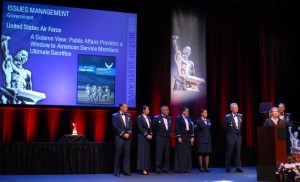Recently, I had the very good pleasure of getting to know Arthur Yann, APR, vice president of public relations for the Public Relations Society of America (PRSA). Arthur offered a terrific comment to my post a while back imploring the PR and communications profession to defend its work, and we have gotten to know each other since then. Arthur even graciously invited me to attend the PRSA Silver Anvil Award ceremony, which was a wonderful event honoring many great contributions to the public relations industry (The photo below is of the Air Force Public Affairs Office accepting an honor at the event.)

Last week, I took some time to chat with Arthur about his role at PRSA, what the organization is aiming to do for future generations of PR professionals, PRSA’s relatively new Business Case for Public Relations initiative and other thoughts and insight on the PR and communications profession.
What is your role at PRSA?
I serve PRSA as vice president, public relations. As you can imagine, being responsible for the Public Relations Society’s public relations program is a unique role. We serve 32,000 professional and student member — all of whom know something about the practice of public relations — so there’s no shortage of advice or criticisms when the members don’t agree with our positions or approach. While that may seem unsettling to some, I see it as a privilege to be able to interact with, and continue to learn from, so many talented and passionate individuals on a daily basis.
My responsibilities really come down to developing and implementing public relations programs to support the achievement of the Society’s organizational goals, and managing our advocacy program, which supports the ethics, standards, reputation and value proposition of the public relations profession. I’m also fortunate to have the proverbial “seat at the table,” from which I counsel our president and COO, Board of Directors and senior staff on operational and reputational issues. Plus, I help to oversee our two in-house publications, Strategist and Tactics.
How long have you been with the organization, both as a member and as an employee?
I’ve been a PRSA employee for two years and an active member for more than 10 years. Before joining the PRSA staff, I served on the Honors and Awards Committee, which is responsible for awarding the Silver Anvil, and as a Silver Anvil judge. I also was a member of Counselor’s Academy during my agency days and a speaker at its conference, but have transitioned to our Association/Non-profit section since joining the staff. I’m also a member of our great New York Chapter and have been a judge for its Big Apple awards program.
What is your professional background? Where did you work before PRSA?
My degree is in journalism, but my entire career has been spent in public relations. I started out in the late 1980s at a small boutique agency in New York after relocating from Pittsburgh, and in my time there I went from being an assistant account executive to an agency principal. In 2003, we sold the firm to Cramer-Krasselt, a Chicago advertising agency, and became the New York office of its public relations division, CKPR. I ran that office for three years and left when my employment contract expired. I then went into health care public relations for a year before joining PRSA.
As VP of PR at PRSA, what has been one of the most challenging, but rewarding, projects you have worked on with the organization?
I’ve been involved in a number of challenging projects—re-launching PRSA’s website, developing our industry advocacy campaign, “The Business Case for Public RelationsTM” overhauling our daily news-digest e-mail, Issues & Trends, and increasing the Society’s use of social media, but one of things I find most rewarding is protecting the organization’s reputation
It’s true that PRSA went through a bit of a fallow period during which the staff leadership turned over and the organization struggled, and its reputation has suffered as a result. But PRSA has substantially reinvented itself under Bill Murray’s leadership over the past three years. We’ve become a data-driven organization, conducting regular member surveys and using the findings to deliver greater member value, develop professional development opportunities that serve the greatest interest and need and be more relevant to the profession, especially to senior practitioners who feel like they’ve “outgrown” our organization.
The difficulty, of course, is that PRSA is not only the largest organization of its kind, it’s the most diverse. We have students, educators, agency heads and staffers, corporate public relations people, sole practitioners, consultants, retired professionals, academics and others who comprise our membership. It’s a challenge to be precisely relevant to each class of member, given their different organizational settings, industry specialties and career stages, but we try. Plus, the competitive landscape is more crowded than ever before, and there are more resources now being given away for free.
Also, as the largest organization of its kind, we’re an easy target for criticism, some of which is deserved, but a lot of which is inaccurate, misleading or agenda-driven, or fails to take the bigger picture into account. I’m often left wishing that individuals would call me to discuss an issue or an idea before putting out a blog or a Tweet, so that I could provide our perspective or clear up misunderstandings. I don’t think that balanced reporting and fact checking are too much to ask — even of citizen journalists — especially if they want to make their point effectively and do it in a credible way.
Check back next week for part two of my interview with PRSA’s Arthur Yann, APR, as Arthur gets into more detail about one of the Society’s biggest initiatives, The Business Case for Public Relations, among other topics.